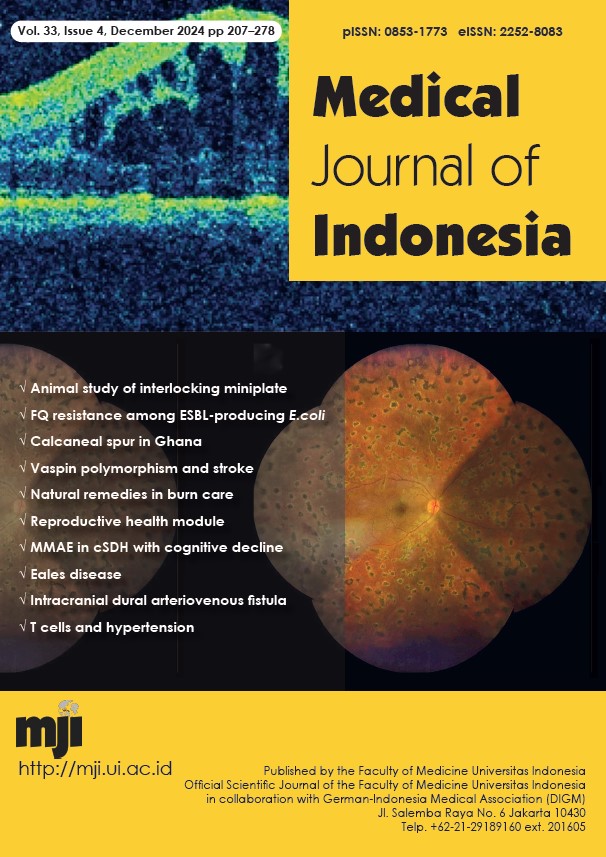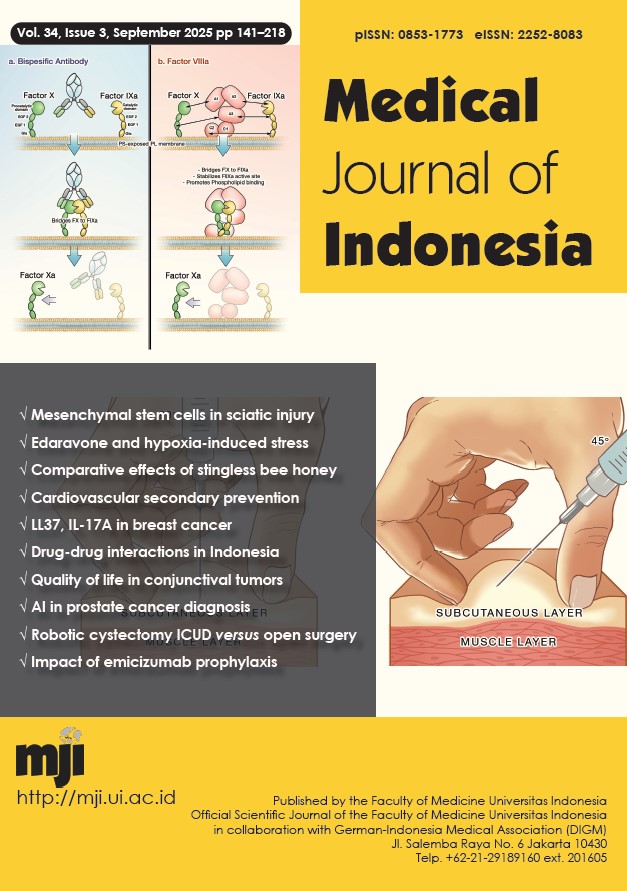Role of regulatory T cells and T helper 17 cells in the pathogenesis of hypertension: a review
DOI:
https://doi.org/10.13181/mji.rev.247521Keywords:
hypertension, immune system, regulatory T cell, T helper 17 cellAbstract
The discovery of autoantibodies in artery samples from cadavers with hypertension over 50 years ago suggested a potential link between the immune system and hypertension. Since then, research exploring the role of the immune system in hypertension has emerged. Animal studies have demonstrated a strong correlation between regulatory T cells (Tregs) and T helper 17 (Th17) cells in hypertension development, yet studies on human hypertension remain limited. Tregs produce inhibitory cytokines such as interleukin (IL)-10 and transforming growth factor-β to act as anti-inflammatory cells that protect against hypertension. In contrast, Th17 cells, by producing IL-17A, function as pro-inflammatory cells that promote hypertension. Recently, a subset of cells known as IL-17A+FOXP3+Treg cells have been identified, which can produce IL-17 and act as inflammatory cells under certain conditions. Understanding the basic mechanisms by which the immune system influences hypertension could lead to targeted immunotherapies for hypertension in the future. Thus, we highlighted the role of Tregs and Th17 cells in the development of hypertension and their potential as targets for therapy. Our findings confirmed the role of Tregs and Th17 cells in the pathogenesis of hypertension.
Downloads
References
Singh MV, Chapleau MW, Harwani SC, Abboud FM. The immune system and hypertension. Immunol Res. 2014;59(1−3):243−53. https://doi.org/10.1007/s12026-014-8548-6
Drummond GR, Vinh A, Guzik TJ, Sobey CG. Immune mechanisms of hypertension. Nat Rev Immunol. 2019;19(8):517−32. https://doi.org/10.1038/s41577-019-0160-5
Chen S, Agrawal DK. Dysregulation of T cell subsets in the pathogenesis of hypertension. Curr Hypertens Rep. 2015;17(2):8. https://doi.org/10.1007/s11906-014-0521-1
Mian MO, Paradis P, Schiffrin EL. Innate immunity in hypertension. Curr Hypertens Rep. 2014;16:413. https://doi.org/10.1007/s11906-013-0413-9
Schroder K, Tschopp J. The inflammasomes. Cell. 2010;140(6):821−32. https://doi.org/10.1016/j.cell.2010.01.040
Rodriguez-Iturbe B, Pons H, Johnson RJ. Role of the immune system in hypertension. Physiol Rev. 2017;97(3):1127−64. https://doi.org/10.1152/physrev.00031.2016
De Ciuceis C, Amiri F, Brassard P, Endemann DH, Touyz RM, Schiffrin EL. Reduced vascular remodeling, endothelial dysfunction, and oxidative stress in resistance arteries of angiotensin II-infused macrophage colony-stimulating factor-deficient mice: evidence for a role in inflammation in angiotensin-induced vascular injury. Arterioscler Thromb Vasc Biol. 2005;25(10):2106−13. https://doi.org/10.1161/01.ATV.0000181743.28028.57
Barhoumi T, Kasal DA, Li MW, Shbat L, Laurant P, Neves MF, et al. T regulatory lymphocytes prevent angiotensin II-induced hypertension and vascular injury. Hypertension. 2011;57(3):469−76. https://doi.org/10.1161/HYPERTENSIONAHA.110.162941
Viel EC, Lemarié CA, Benkirane K, Paradis P, Schiffrin EL. Immune regulation and vascular inflammation in genetic hypertension. Am J Physiol Heart Circ Physiol. 2010;298(3):H938−44. https://doi.org/10.1152/ajpheart.00707.2009
Kossmann S, Schwenk M, Hausding M, Karbach SH, Schmidgen MI, Brandt M, et al. Angiotensin II-induced vascular dysfunction depends on interferon-γ-driven immune cell recruitment and mutual activation of monocytes and NK-cells. Arterioscler Thromb Vasc Biol. 2013;33(6):1313−9. https://doi.org/10.1161/ATVBAHA.113.301437
Hashimoto D, Miller J, Merad M. Dendritic cell and macrophage heterogeneity in vivo. Immunity. 2011;35(3):323−35. https://doi.org/10.1016/j.immuni.2011.09.007
Vinh A, Chen W, Blinder Y, Weiss D, Taylor WR, Goronzy JJ, et al. Inhibition and genetic ablation of the B7/CD28 T-cell costimulation axis prevents experimental hypertension. Circulation. 2010;122(24):2529−37. https://doi.org/10.1161/CIRCULATIONAHA.109.930446
Blake GJ, Rifai N, Buring JE, Ridker PM. Blood pressure, C-reactive protein, and risk of future cardiovascular events. Circulation. 2003;108(24):2993−9. https://doi.org/10.1161/01.CIR.0000104566.10178.AF
Marketou ME, Kontaraki JE, Zacharis EA, Kochiadakis GE, Giaouzaki A, Chlouverakis G, et al. TLR2 and TLR4 gene expression in peripheral monocytes in nondiabetic hypertensive patients: the effect of intensive blood pressure-lowering. J Clin Hypertens (Greenwich). 2012;14(5):330−5. https://doi.org/10.1111/j.1751-7176.2012.00620.x
Imakiire T, Kikuchi Y, Yamada M, Kushiyama T, Higashi K, Hyodo N, et al. Effects of renin-angiotensin system blockade on macrophage infiltration in patients with hypertensive nephrosclerosis. Hypertens Res. 2007;30(7):635−42. https://doi.org/10.1291/hypres.30.635
Curtsinger JM, Mescher MF. Inflammatory cytokines as a third signal for T cell activation. Curr Opin Immunol. 2010;22(3):333−40. https://doi.org/10.1016/j.coi.2010.02.013
Gaffen SL. Recent advances in the IL-17 cytokine family. Curr Opin Immunol. 2011;23(5):613−9. https://doi.org/10.1016/j.coi.2011.07.006
Okuda T, Grollman A. Passive transfer of autoimmune induced hypertension in the rat by lymph node cells. Tex Rep Biol Med. 1967;25(2):257−64.
Mattson DL, Lund H, Guo C, Rudemiller N, Geurts AM, Jacob H. Genetic mutation of recombination activating gene 1 in Dahl salt-sensitive rats attenuates hypertension and renal damage. Am J Physiol Regul Integr Comp Physiol. 2013;304(6):R407−14. https://doi.org/10.1152/ajpregu.00304.2012
Novotny SR, Wallace K, Heath J, Moseley J, Dhillon P, Weimer A, et al. Activating autoantibodies to the angiotensin II type I receptor play an important role in mediating hypertension in response to adoptive transfer of CD4+ T lymphocytes from placental ischemic rats. Am J Physiol Regul Integr Comp Physiol. 2012;302(10):R1197−201. https://doi.org/10.1152/ajpregu.00623.2011
Amin HZ, Sasaki N, Hirata KI. Regulatory T cell immunity in atherosclerosis. Acta Med Indones. 2017;49(1):63−8.
Kimura A, Kishimoto T. IL-6: regulator of Treg/Th17 balance. Eur J Immunol. 2010;40(7):1830−5. https://doi.org/10.1002/eji.201040391
Vignali DA, Collison LW, Workman CJ. How regulatory T cells work. Nat Rev Immunol. 2008;8(7):523−32. https://doi.org/10.1038/nri2343
Annacker O, Asseman C, Read S, Powrie F. Interleukin-10 in the regulation of T cell-induced colitis. J Autoimmun. 2003;20(4):277−9. https://doi.org/10.1016/S0896-8411(03)00045-3
Green EA, Gorelik L, McGregor CM, Tran EH, Flavell RA. CD4⁺CD25⁺ T regulatory cells control anti-islet CD8⁺ T cells through TGF-β-TGF-β receptor interactions in type 1 diabetes. Proc Natl Acad Sci U S A. 2003;100(19):10878−83. https://doi.org/10.1073/pnas.1834400100
Matrougui K, Abd Elmageed Z, Kassan M, Choi S, Nair D, Gonzalez-Villalobos RA, et al. Natural regulatory T cells control coronary arteriolar endothelial dysfunction in hypertensive mice. Am J Pathol. 2011;178(1):434−41. https://doi.org/10.1016/j.ajpath.2010.11.034
Ryan MJ, Didion SP, Mathur S, Faraci FM, Sigmund CD. Angiotensin II-induced vascular dysfunction is mediated by the AT1A receptor in mice. Hypertension. 2004;43(5):1074−9. https://doi.org/10.1161/01.HYP.0000123074.89717.3d
Madhur MS, Lob HE, McCann LA, Iwakura Y, Blinder Y, Guzik TJ, et al. Interleukin 17 promotes angiotensin II-induced hypertension and vascular dysfunction. Hypertension. 2010;55(2):500−7. https://doi.org/10.1161/HYPERTENSIONAHA.109.145094
Kassan M, Wecker A, Kadowitz P, Trebak M, Matrougui K. CD4+CD25+Foxp3 regulatory T cells and vascular dysfunction in hypertension. J Hypertens. 2013;31(10):1939−43. https://doi.org/10.1097/HJH.0b013e328362feb7
Hafeez NA, Fouda Mel-T, Abdel Gawad ER, Assar T, Mansour AI. The role of regulatory T cells in preeclampsia. Egypt J Immunol. 2014;21(1):45−55.
Gackowska L, Michalkiewicz J, Helmin-Basa A, Klosowski M, Niemirska A, Obrycki L, et al. Regulatory T-cell subset distribution in children with primary hypertension is associated with hypertension severity and hypertensive target organ damage. J Hypertens. 2020;38(4):692−700. https://doi.org/10.1097/HJH.0000000000002328
Alexander MR, Dale BL, Smart CD, Elijovich F, Wogsland CE, Lima SM, et al. Immune profiling reveals decreases in circulating regulatory and exhausted T cells in human hypertension. JACC Basic Transl Sci. 2023;8(3):319−36. https://doi.org/10.1016/j.jacbts.2022.09.007
Tesmer LA, Lundy SK, Sarkar S, Fox DA. Th17 cells in human disease. Immunol Rev. 2008;223:87−113. https://doi.org/10.1111/j.1600-065X.2008.00628.x
Amador CA, Barrientos V, Peña J, Herrada AA, González M, Valdés S, et al. Spironolactone decreases DOCA-salt-induced organ damage by blocking the activation of T helper 17 and the downregulation of regulatory T lymphocytes. Hypertension. 2014;63(4):797−803. https://doi.org/10.1161/HYPERTENSIONAHA.113.02883
Xie JJ, Wang J, Tang TT, Chen J, Gao XL, Yuan J, et al. The Th17/Treg functional imbalance during atherogenesis in ApoE(-/-) mice. Cytokine. 2010;49(2):185−93. https://doi.org/10.1016/j.cyto.2009.09.007
Beriou G, Costantino CM, Ashley CW, Yang L, Kuchroo VK, Baecher-Allan C, et al. IL-17-producing human peripheral regulatory T cells retain suppressive function. Blood. 2009;113(18):4240−9. https://doi.org/10.1182/blood-2008-10-183251
Putra SD, Muliawan HS, Widyantoro B. The association between regulatory T-cell and hypertension [thesis]. Universitas Indonesia: Faculty of Medicine; 2023.
Nakagami H, Ishihama T, Daikyoji Y, Sasakura C, Yamada E, Morishita R. Brief report on a phase I/IIa study to assess the safety, tolerability, and immune response of AGMG0201 in patients with essential hypertension. Hypertens Res. 2022;45(1):61−5. https://doi.org/10.1038/s41440-021-00755-6
Published
How to Cite
Issue
Section
License
Copyright (c) 2025 Hary Sakti Muliawan, Swastya Dwi Putra, Hilman Zulkifli Amin, Bambang Widyantoro

This work is licensed under a Creative Commons Attribution-NonCommercial 4.0 International License.
Authors who publish with Medical Journal of Indonesia agree to the following terms:
- Authors retain copyright and grant Medical Journal of Indonesia right of first publication with the work simultaneously licensed under a Creative Commons Attribution-NonCommercial License that allows others to remix, adapt, build upon the work non-commercially with an acknowledgment of the work’s authorship and initial publication in Medical Journal of Indonesia.
- Authors are permitted to copy and redistribute the journal's published version of the work non-commercially (e.g., post it to an institutional repository or publish it in a book), with an acknowledgment of its initial publication in Medical Journal of Indonesia.






































